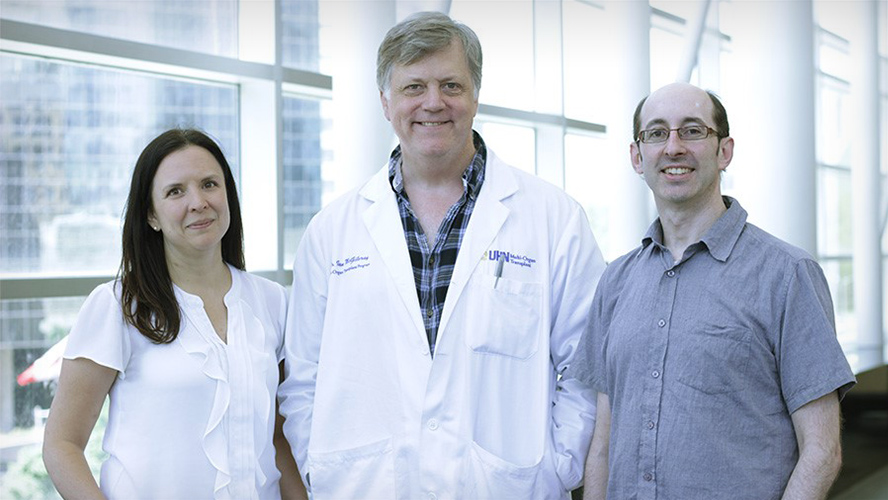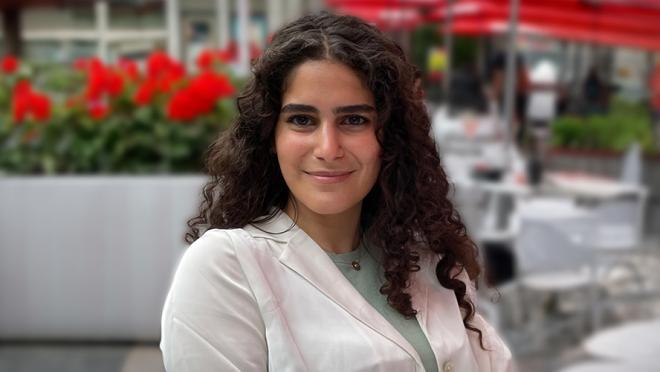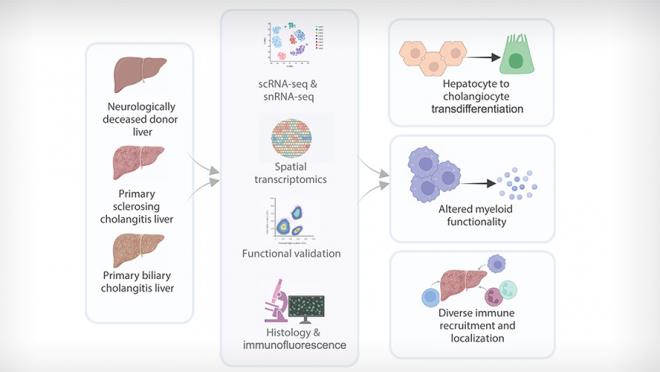
A leading-edge effort led by the University Health Network (UHN) in Toronto, in collaboration with a team of researchers from the University of Toronto, Hospital for Sick Children (SickKids), and Western University, has published a new study in the Journal of Hepatology that gives the first-ever snapshot of primary sclerosing cholangitis (PSC), a rare autoimmune liver disease.
There are more than 3,000 Canadians living with PSC, which damages the bile ducts inside and outside the liver. There is no cure for PSC, but there are medications and procedures to relieve symptoms. When the disease has progressed to liver failure, liver transplantation may be considered.
The research is focused on understanding the cellular landscape of the PSC liver at the time of transplant. Utilizing innovative, cutting-edge techniques, the team could pinpoint cells crucial to disease progression, providing valuable insights for potential therapeutic targets.
"PSC is a rare cholestatic liver disease that is often overlooked in research. Our findings shed light on cellular populations driving disease progression, opening avenues for therapeutic development," says study co-first author Diana Nakib, a Ph.D. candidate at the lab of Dr. Sonya MacParland, Senior Scientist at UHN’s Schwartz Reisman Liver Research Centre, Ajmera Transplant Centre and Toronto General Hospital Research Institute (TGHRI).

Diana Nakib, a Ph.D. candidate in the lab of Dr. Sonya MacParland, is co-first author of the study. (Photo: Courtesy Diana Nakib)
Dr. MacParland, co-senior author of the study and an Associate Professor at the University of Toronto, emphasizes the importance of understanding the healthy liver, "Our growing knowledge of the healthy human liver enables us to identify and target cells driving diseases like PSC."
The study's multi-omic approach revealed vital insights, including diverse immune cell populations in the healthy liver, in PSC livers, and transitioning liver cells around PSC lesions. Dr. Gary Bader, a co-senior author, Affiliate Scientist at the Princess Margaret Cancer Centre and Professor at the University of Toronto’s Donnelly Centre, highlights the importance of a multi-omic approach,
A further distinguishing characteristic of this research is that it prioritizes open science, collaboration and a patient-centric approach, where patients actively participated in the grant writing, and a patient advocacy group – PSC Partners Seeking a Cure Canada – contributed funding.
It’s part of a new trend where patients are involved at every step of the research and have direct input into the formulation and direction. In this case, Mary Vyas, from PSC Partners Seeking a Cure Canada, was part of the grant writing team and participated in disseminating the data as it was generated to the patient group through a recent UHN-supported patient partnered conference entitled "What the Cell!?"
"PSC Partners Seeking a Cure Canada has been instrumental in study design, priority setting, and knowledge dissemination. Their input brings us closer to uncovering therapeutic targets," says co-senior author Dr. Ian McGilvray, Head of Liver and Pancreas Surgery at UHN’s Sprott Department of Surgery, Surgeon and Scientist at UHN’s Ajmera Transplant Centre, Co-Director of UHN’s Schwartz Reisman Liver Research Centre, and Professor at the University of Toronto.
This patient-centric research not only brings rare diseases into focus but also accelerates drug discovery, exemplifying the power of collaboration and open science in advancing medical breakthroughs, bringing hope to those affected by conditions long overlooked.
"Sharing raw and processed data publicly facilitates global collaboration, especially for underserved liver diseases," Dr. Tallulah Andrews, a co-first author and Assistant Professor at the Western University, stresses the impact of their open-science approach.

The team employed single-cell, single-nucleus and spatial transcriptomic technologies to uncover distinct cell types and their localization in rare liver disease, primary sclerosing cholangitis (PSC).
This team was supported by UHN Foundation; Chan Zuckerberg Initiative DAF, an advised fund of Silicon Valley Community Foundation; an early researcher award from the Government of Ontario; funds from the University of Toronto’s Medicine by Design initiative, which receives funding from the Canada First Research Excellence Fund (CFREF); the NRNB (U.S. National Institutes of Health; Canadian Institutes of Health Research; Canadian Network on Hepatitis C; Public Health Agency of Canada (PHAC); PSC Partners Seeking a Cure Canada; the Canadian Autoimmunity Standardization Core (CIHR).
Andrews TS*, Nakib D*, Perciani CT, Ma XM, Liu L, Winter E, Camat D, Chung SW, Lumanto P Manuel J, Mangroo S, Hansen B, Arpinder B, Thoeni C, Sayed B, Feld J, Gehring A, Gulamhusein A, Hirschfield GM, Ricciuto A, Bader GD, McGilvray ID, MacParland SA. Single-cell and spatial transcriptomics characterisation of the immunological landscape in the healthy and PSC human liver. Journal of Hepatology. 2024 Jan 9. https://doi.org/10.1016/j.jhep.2023.12.023*co-first authors




